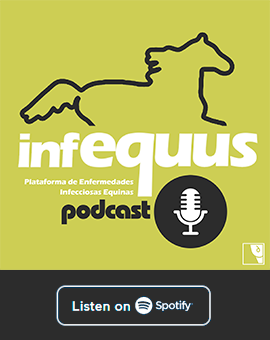Rhodococcus equi Pneumonia
Etiology
Aerobic, nonmotile, pleomorphic, gram-positive, intracellular bacteria (formerly known as Corynebacterium equi and Mycobacterium equi). Both avirulent and virulent strains have been isolated, the last ones contain a virulent plasmid that expresses VapA gene, which codifies for a highly immunogenic surface lipoprotein, considered the main responsible for clinical disease in foals.
Epidemiology
R. equi has been isolated from a great variety of aquatic and land species, normally without clinical significance, except in foals. It can be found in soil and manure of herbivores, especially from equids. Adult horses are asymptomatic carriers of R.equi. Its distribution is global, with endemic presence in many farms. Replication optimal conditions are warm temperatures, low humidity and soils with neutral pH. The main route of infection in foals is inhalatory through dust particles. High airborne concentrations of bacteria, elevated animal density and foals immunitary state are considered risk factors of disease. Incubation period is highly variable, with an association between the onset of clinical disease and the decline in maternal antibodies. Thus, although foals usually are exposed to R. equi in the first days of life, they do not manifest illness until 3 weeks to 6 months of age. Once established, the infection could disseminate by haematogenous spread.
Pathogeny
R. equi infects and destroys macrophages and monocytes. Bacteria reach these cells by active phagocytosis through complement pathway. Virulent plasmid is essential to survival and replication of bacteria. Once within the cell, it multiplies inside vacuoles, altering the phagocyte maturation process and inducing cell death. The large number of cells at the site of infection result in granuloma formation. The majority of foals are exposed to R. equi, but many of them do not develop the disease. Adult horses are resistant to infection. It is suggested that the quality of the individual immune response is associated to the development of clinical disease. Innate response, VapA specific antibodies and lymphocyte T cellular immunity are decisive for infection control.
Clinical signs
Rhodococcus mainly affects respiratory tract and less frequently can infect other organs. General clinical signs include fever, lethargy and decreased appetite. Disease presentation is usually chronic. At the pulmonary presentation, is usual to find chronic pyogranulomatous bronchopneumonia with associated suppurative lymphadenitis. Extrapulmonary alterations include abdominal lesions (intestinal inflammation, peritonitis and abdominal abscesses), joint damage (aseptic polysynovitis, septic arthritis and osteomyelitis) and abscesses at any location. Disease is rare in adult horses, usually associated with immunocompromised animals.
Diagnosis
Recommended diagnostic protocol is through bacteriologic culture and PCR amplification of VapA gene from tracheobronchial aspirate in cases of bronchopneumonia and samples from other locations in cases of extrapulmonary infection. Other techniques utilized for R. equi diagnosis are cytology, serologic test (ELISA and AGID among others) and biopathology where frequent findings are hyperfibrinogenemia, neutrophilic leukocytosis and thrombocytosis, although they are not specific. Pulmonary radiology is the most used image technique, where alveolar pattern, regional consolidation, abscesses and traqueobronchial lymphadenopathy are often found. Thoracic ultrasound is used mainly to evaluate pulmonary surface. MRI, CT and scintigraphy are other techniques employed, mostly at extrapulmonary infections. Characteristic pulmonary macroscopic lesions include nodules, congestion and atelectasis, normally bilateral at cranioventral region. Histologically, lesions are pyogranulomatous, with numerous macrophages and giant cells, where bacteria could be observed. Intestinal and lymphoid tissue pyogranulomatous inflammation, septic arthritis, vertebral osteomyelitis, hypopyon, and ulcerative lymphangitis are other lesions observed. Immunohistochemistry could be used as a diagnostic technique.
Treatment
Macrolide antibiotics are recommended (erythromycin 25mg/kg PO q6-8h, azithromycin 10mg/kg PO q24h 5d and q48 thereafter or clarithromycin 7.5mg/kg PO q12h) in combination with rifampin (5-10mg/kg PO q12h or 10mg/kg q24h). They are lipid-soluble antibiotics able to penetrate into granulocytes and macrophages where they have bacteriostatic or bactericidal action, depending on their concentration. Treatment should be continued from 3 to 12 weeks until resolution of clinical, analytical and image alterations. Adverse effects of therapy are diarrhea, hyperthermia and respiratory distress. Resistant strains to these antibiotics have been found, with variable susceptibility patterns. Supportive care depends on gravity of infection and includes oxygen therapy, bronchodilators, NAIDs, fatty acids supplementation, regional perfusion and surgical removal of abscesses. Current survival rate is 60 to 90%. Severe tachycardia, respiratory distress and severe radiographic lesions are indicators of poor prognosis, as well as abdominal abscesses and osteomyelitis. Prognosis for performance in uncomplicated cases of pneumonia is usually excellent.
Prevention and control
Prevention and control strategies consist in:
- Decreasing the number of microorganisms in the environment by lowering animal density, removing manure from pastures and reducing the level of dust, not being necessary the isolation of infected foals.
- Early detection of disease through screening at endemic farms, physical examination, leukocyte and fibrinogen measurement and thoracic ultrasound in susceptible foals.
- Passive immunization through hyperimmune plasma administration at endemic farms and active immunization with vaccines, although to the date, none of the developed vaccines has proved to be effective.
Public Health Considerations
R. equi is considered an emerging pathogen in human medicine, affecting mostly to immunocompromised patients (mainly HIV).
References
- Equine Infectious Diseases. 2014 Elsevier Inc. ISBN: 978-1-4557-0891-8.
- Rofe, A. P., et al. (2017). "The Rhodococcus equi virulence protein VapA disrupts endolysosome function and stimulates lysosome biogenesis." MicrobiologyOpen 6(2)
- Giguère, S., et al. (2011). "Diagnosis, Treatment, Control, and Prevention of Infections Caused by R hodococcus equi in Foals." J Vet Intern Med 25(6):1209-1220.
- Weinstock, D. M. and A. E. Brown (2002). "Rhodococcus equi: an emerging pathogen." Clinical Infectious Diseases 34(10):1379-1385
- thehorse.com

